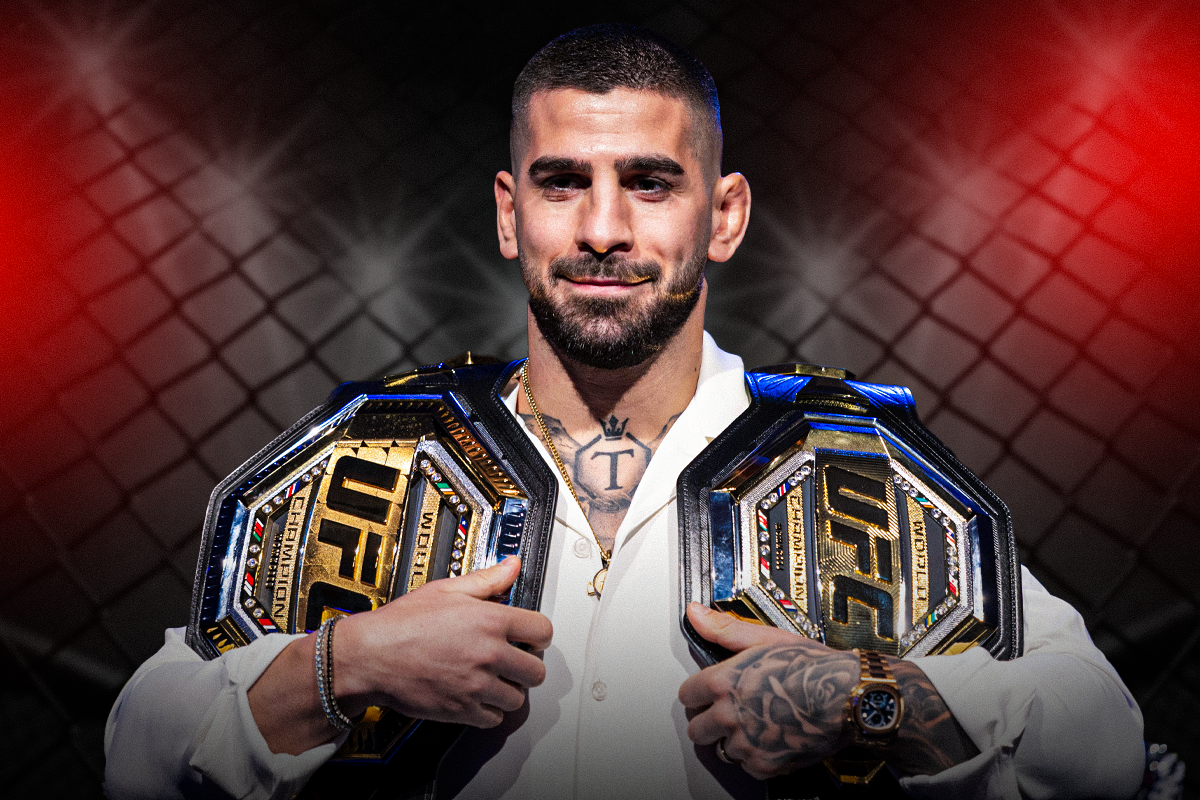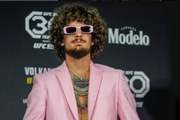
Imago
Credits: IMAGO

Imago
Credits: IMAGO
For almost two decades now, the lightweight division has been the UFC’s marquee weight class. On the surface, the current state of the 155 lbs division might just look fine. A highly accomplished champion, Ilia Topuria, has recently ascended the throne by defeating Charles Oliveira at UFC 317. Behind him stand contenders like Paddy Pimblett, Arman Tsarukyan, and Justin Gaethje—each eager to face him for a title shot. Yet, there are some real issues currently developing in the division. And it’s not about 155 pounds lacking star power. It’s about the activity. Yes, lightweight simply isn’t flowing the way it once did, at least at the top. And to prove it, I’ll walk you through the entire timeline of arguably the most competitive UFC division ever.
Watch What’s Trending Now!
In 2015, the division set a record with 100 fights, resulting in 24 knockouts, 21 submissions, and an impressive 54 decisions. Since then, the weight class has consistently offered 70–80 bouts per year, rivaled only by welterweight in activity. On top of that, 155 lbs has also crowned some of the sport’s greatest champions. BJ Penn, Khabib Nurmagomedov, and, in recent years, Charles Oliveira and Islam Makhachev. With some of the most high-profile fighters in the world, the entertainment factor always remained intact within this division, until now.
ADVERTISEMENT
Legacy of the UFC lightweight division: Early days of glory
To truly understand what’s wrong with today’s 155 lbs division, we need to revisit its past. Back in 2001, Jens Pulver made history as the first-ever lightweight champion, defeating Caol Uno at UFC 30. But after a contract dispute, Pulver was stripped of the title, leading to a four-man tournament whose finale between B.J. Penn and Uno for the vacant belt ultimately ended in a draw. It wasn’t until 2006 that Sean Sherk defeated Kenny Florian to finally bring stability to the division.
‘The Muscle Shark’ even went on to defend the title against Hermes França at UFC 73. He’s often credited with reviving the lightweight division—but nobody was prepared for what came next. Sherk’s reign ended tragically when he was stripped of the title for failing a drug test. Then it was time for B.J. Penn, who became the first champion to dominate the division with an iron fist.
Top Stories
Justin Gaethje Addresses UFC 324 Cancellation Concerns Over Staph Infection

Jon Jones vs. Daniel Cormier 3 Announced in a Surprising Move by UFC Legends

Sean O’Malley Says UFC White House Victory Could Push Him Toward Retirement

Alex Pereira Brings His Father to Tears With Heartfelt Gift

Alexandre Pantoja’s UFC Return Timeline Revealed in Positive Injury Update


Imago
Credits: IMAGO
‘The Prodigy’ defeated Joe Stevenson at UFC 80 in Newcastle, England, to claim the lightweight crown in 2008. During his 812-day reign, he defended the belt three times against Sean Sherk, Kenny Florian, and Diego Sanchez, a testament to how the Hawaiian champ overcame fierce competition. But his wins were also impressive because, at the time, the contenders were pretty seasoned.
ADVERTISEMENT
Florian was on a six-fight winning streak—fighting three times in 2007 and 2008—before earning a title shot. So, contenders really had it tough back then. The situation didn’t change much when Frankie Edgar dethroned BJ Penn at UFC 118, back in 2010.
ADVERTISEMENT
The new lightweight champ had to face Gray Maynard, who was riding an eight-fight winning streak. For the unversed, it wasn’t like Maynard fought easy opponents. He defeated Roger Huerta, Kenny Florian, and Nate Diaz in the span of a year to earn his title shot. That’s what you call activity! However, the scenario started to transform a little bit when Benson Henderson succeeded him as the new champion.
‘Smooth’s path was far from living up to his nickname. From the start, he had to go through a murderer’s row that included prime Jim Miller and Clay Guida just to reach the reigning champ, Edgar. After taking the belt off ‘The Answer’ at UFC 144, and then defending it in a rematch at UFC 150, Henderson had already achieved a formidable champ status. Then, he faced Nate Diaz, who, despite earning three consecutive performance bonuses, had only one ranked win over Miller.
Henderson’s next successful defense was against Gilbert Melendez, who got his shot at the gold because of his Strikeforce accomplishments. Though Benderson made it to three title defenses, in 2013, Anthony Pettis dethroned ‘Smooth’ at UFC 164, ushering in a new era in the lightweight division.
ADVERTISEMENT
So, although there were fewer contenders back then, the division remained highly active because the champions and the contenders were constantly facing each other. However, in the years that followed, significant changes began to take shape, altering the landscape.
Conor McGregor and the ‘stuck in the mud’ division
After ‘Showtime’ became the poster boy of the 155-pounders, many believed he would remain champion for a long time. His first defense against Melendez also showed great promise. However, Rafael dos Anjos quickly became his nemesis at UFC 185 by showing him levels inside the Octagon. After a few months, the Brazilian knocked out Donald Cerrone at UFC on Fox 17, defending his belt for the first time.
ADVERTISEMENT
This amazing performance made many fans think that he might be the next face of the division. But Eddie Alvarez proved everyone wrong, decisively dismantling dos Anjos at UFC Fight Night 90. ‘The Underground King’ quickly gained a reputation for his amazing fighting style and forward pressing approach. But his reign was also cut short. Because what followed was pure history.

Imago
Credits: IMAGO
At UFC 205, then-featherweight champion Conor McGregor moved up a division to challenge Alvarez for the 155 lbs belt—and it was a masterclass! ‘The Notorious’ hoisted two belts in front of the Madison Square Garden crowd. Fans hoped the Irishman would revitalize what he called the “stuck-in-the-mud” division. But disappointment followed.
ADVERTISEMENT
McGregor focused on the biggest payday of his career against Floyd Mayweather in a historic crossover boxing bout. So, the UFC lightweight division technically had a champion, but it also didn’t. While ‘Mystic Mac’ was sitting out without defending his belt, Pettis and dos Anjos only managed to defend their belts once each before him. McGregor did not become a solution to the ‘stuck in the mud’ problem; he added to it. The question was how long he could hold up the division for. The answer – the next batch of hardened lightweight contenders!
Even as championship activity slowed, the contenders didn’t stop lighting up the Octagon. In 2017, UFC fans were treated to incredible fights like Tony Ferguson vs. Kevin Lee and Justin Gaethje vs. Eddie Alvarez. In the meantime, former featherweight Dustin Poirier quickly emerged as a dark horse, defeating Jim Miller, Anthony Pettis, Gaethje, and Alvarez. Their rise breathed new life into the lightweight division. Yet, all eyes were on one undefeated gentleman from Dagestan.
The UFC finally decided to strip McGregor of the title after prolonged inactivity. And as a result, at UFC 223, Khabib Nurmagomedov made history by defeating Al Iaquinta convincingly to claim the lightweight crown. And he didn’t just become champion—‘The Eagle’ also started a new era of domination.
ADVERTISEMENT
The Dagestani-Brazilian lightweight era of domination
After ‘The Eagle’ became the 155 lbs division’s new king, fans quickly realized he would be a nightmare for any contender. That proved true when he dominated Conor McGregor at UFC 229 inside the T-Mobile Arena. Following the biggest fight in UFC history, every lightweight challenger wanted to face Khabib. Yet, only three main contenders were truly on the frontline to challenge the champ for the title
Between 2019 and 2020, the 155 lbs ranking looked promising. Islam Makhachev was steadily building his reputation as a legitimate contender. Fans quickly started seeing him as the natural heir to the throne once ‘The Eagle’ decided to retire. Other ranked opponents included Paul Felder, Dan Hooker, and Charles Oliveira. Meanwhile, Justin Gaethje and Dustin Poirier had earned reputations as legends, delivering multiple wars inside the cage.
ADVERTISEMENT
Eventually, both Poirier and Gaethje had their chance to face the undefeated legend. ‘The Diamond’ got to face Khabib at UFC 242 in Abu Dhabi—and after two rounds of struggle, Poirier submitted to a rear-naked choke. The consequences were not very different when Gaethje fought ‘The Eagle’ at UFC 254 either.

Imago
Credits: IMAGO
The Highlight’ also surrendered under Khabib’s deadly triangle choke at the start of the second round. So, after defeating McGregor and two solid contenders back to back, the Russian thought it was enough and retired with an unblemished 29-0 record. Then came the reign of ‘Do Bronx’, which fans on the internet have dubbed the ‘Olive-era.’
Charles Oliveira claimed the vacant lightweight belt by defeating Michael Chandler at UFC 262. It was definitely a fresh matchup for the division. Still, it didn’t take long for Poirier and Gaethje to reestablish themselves as top contenders. The Louisiana slugger beat Dan Hooker to a pulp and earned two career-defining wins over McGregor to secure a shot against Oliveira at UFC 269—only to come up short against another rear-naked choke.
Meanwhile, the Arizona powerhouse delivered another fight-of-the-lifetime against Chandler at UFC 268, earning a title shot against Oliveira. Unfortunately, Gaethje also fell short against the Brazilian submission artist. But, slowly, the water of the lightweight division was starting to get a little shallow.
It was only when Oliveira missed weight at UFC 274 against Gaethje that the belt became vacant, which Islam Makhachev eventually captured at UFC 280, beating Oliveira, making the division interesting once again.
This was not because he faced a homegrown contender, but because Alexander Volkanovski moved up to deliver the best performance of his career against the Dagestani at UFC 284. Their rematch at UFC 294 happened because the first bout had been competitive enough. However, Islam reigned supreme, dismantling ‘Volk’ with a headkick that sent the featherweight champion into a decline. After that, the lightweight division became pretty stagnant.
Dustin Poirier ended up stopping an up-and-coming contender, Benoît Saint Denis, at UFC 299. And in the next PPV, Max Holloway’s insane last-second knockout of Justin Gaethje at UFC 300 almost snubbed any chances of ‘The Highlight’ getting a third title shot. Fortunately, ‘Blessed’ decided to move back into the featherweight division, which, in hindsight, helped ‘The Diamond’ get another crack at lightweight gold.
Poirier’s fortunes rose again, setting up a showdown with Islam Makhachev at UFC 302—still holding the title of best fighter never to win a UFC undisputed belt. After submitting Poirier at the end of a gritty five-round slugfest, the Dagestani Juggernaut was about to face Arman Tsarukyan at UFC 311.
However, the Armenian, suffering a last-minute back spasm, withdrew from the match-up, leaving Islam securing an easy victory over Renato Moicano at the same event. From that discussion, it is clear that, aside from Arman, fans largely expected the Dagestani to win against anybody in the division.
This predictability became a headache for the matchmakers. According to the rankings, no one else made much sense as a challenger—the question was simple: who could face such a dominant force? Dana White seemed to have one answer: the former 145 lbs champ, Ilia Topuria. But then Makhachev decided to move up to the welterweight division after Jack Della Maddalena bested Belal Muhammad at UFC 315, creating an entirely new problem.
The post-Dagestani era and the UFC lightweight stalemate
At UFC 317, ‘El Matador’ came through on his promise and KO’d Charles Oliveira in the first round to become a two-division champion. He also had a heated faceoff with Paddy Pimblett, reigniting their rivalry ahead of UFC Fight Night England. Fans were intrigued not just by the bad blood. They also want to see an improved Paddy ‘The Baddy’ taking on his bitter rival.
Meanwhile, at the International Fight Week event, the cameras also captured two other challengers in the crowd: Arman Tsarukyan and Justin Gaethje. Both are waiting for their chance at the title. And, truth be told, any one of those matchups would sell out an arena instantly. Yet, there’s still confusion about who will face Topuria next—is it a rivalry bout against Paddy, the number-one contender Tsarukyan, or a legendary clash with Gaethje? Each of them comes with its own complications.
View this post on Instagram
Paddy definitely had a solid win over Michael Chandler at UFC 314, but he hasn’t defeated a top-five lightweight yet. So the Liverpudlian might need another win before the UFC 317 face-off can be justified. The situation for Arman isn’t much better either.
Although he’s ranked number one and getting most of the votes to face Topuria next, it’s also true that after beating Oliveira at UFC 300, he hasn’t fought in over a year. And if you remember Dana White’s statement, he made it clear at the UFC 314 post-fight presser that Arman wouldn’t get an immediate title shot
So, the fans started arguing about ‘Akhalkalakets’ being healthy for recent grappling matches. Why then could he not compete against a contender and cement his place?
On the other side, ‘The Highlight’ announced that he’s only interested in a title fight after defeating Rafael Fiziev at UFC 313—otherwise, retirement is next. And just like the other two fighters, the fans weren’t thrilled with how Gaethje demanded the shot without being on a win streak.
As Ilia Topuria shines as 2025’s star champion, it’s becoming tough for the promotion to organize contender fights, like Paddy vs. Arman or Gaethje, to determine what’s next for the Georgian-Spaniard. The current lightweight champion hasn’t been very active this year, creating further stagnation in the division. Surprisingly, a Dan Hooker vs. Arman Tsarukyan matchup is also in talks, which would be interesting to watch if it materializes.
All this shows just how complex matchmaking has turned compared to previous eras. With that being said, the UFC’s upcoming deal with Paramount+ CBS next year might encourage some movement in this marquee division. And the best-case scenario – the UFC gets Topuria to squeeze in his first lightweight title defense before the year is up – possibly on the December PPV.
ADVERTISEMENT
ADVERTISEMENT
ADVERTISEMENT

